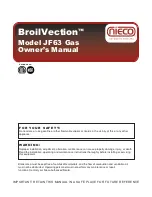
30
BECKETT AFG OR CF375 OIL BURNER
A Beckett model AFG oil burner is used to fire
boilers at 2.00 gph or less. At firing rates above 2.00
gph, a Beckett model CF375 is required. A model
AFG burner shipped with your PF Series boiler
is equipped with an F3 flame retention head, the
size most commonly used. It is possible the head
must be changed to match the nozzle firing rate
required, and it is recommended the installer carry
a complete assortment of Beckett flame retention
heads. When head ratings overlap, a smaller head
with air shutter fairly well open will generally provide
better combustion than a larger head with air shutter
near closed. See head size selection chart on page
21. For firing rates under 1.00 gph. see page 18 for
information on using low firing rate baffles.
It should be recognized that the description of spray
patterns might vary between nozzle manufacturers.
In any case the nozzle recommended is that which
provides the highest CO
2
with the least smoke for a
particular application.
SUGGESTED NOZZLES, HEADS, AND
PRELIMINARY AIR SETTINGS FOR VARIOUS
FIRING RATES AND BURNERS ARE SHOWN
ON PAGES 6 AND 7.
L8151 CONTROL SETTINGS
Use the following setting for the first adjustment:
High Setting ............... 180°F
Low Setting ................ 160°F
Differential .................... 20°F
These settings may be altered based on the heating
system response. During very cold weather if the
heating system, does not provide quite enough
heat, the high limit control setting may be raised to
a maximum of 200°F. If more domestic hot water is
required, the low limit control setting may also be
raised to a maximum of 180°F. Whenever adjusting
either the high or low limit the high limit control
setting must be set at least 20°F above the low
limit. The differential control setting is typically 20°F
but may be adjusted to vary the time it takes the
burner to respond to a call for domestic hot water.
WEATHERPROOF OIL BURNER AND CONTROLS (STARTUP AND ADJUSTMENT)
!
!
!
!
ALTERNATE AIR ELIMINATION METHOD
As boiler temperature increases, air will move from
top of boiler toward float vent even if lower. As
boiler temperature decreases, water will move from
expansion tank toward boiler.
(
See
Figure #8
)
This boiler was designed to produce the ultimate in
usable heat from a gallon of fuel oil.
WARNING
DO NOT ADJUST AIR-FUEL MIXTURE BY EYE.
Adjusting air-fuel mixture by eye wastes fuel
and creates soot. Any time air adjustment
or oil rate is changed, combustion must be
checked with instruments.
With chamber fully warmed up, find highest CO
2
level at which zero smoke can be maintained.
Then add extra air until CO
2
falls off about 1%.
Final setting should be at least 11% CO
2
. If unable
to obtain that reading, check for internal oil leaks,
incorrect flame retention head of faulty or incorrect
nozzle. Draft will vary as air is adjusted. It should
be left at as near zero as possible at breeching.
The correct nozzle is the smallest which will do the
job properly. Long continuous runs with minimum
starts and stops conserve the most energy. The
nozzle which provides the highest CO
2
with the
least smoke for a particular application is always
recommended.
WARNING
A firing rate that is too low can result in a
condensation problem within the chimney
and boiler, causing severe rust and corrosion.
When domestic water is being heated, bypass
piping is recommended only when an indirect
water heater is used as shown on Figure
14. If no domestic water heating is involved,
by-pass piping is always recommended as
shown on
Figure #6
.
Summary of Contents for ULTIMATE PF Series
Page 2: ......
Page 16: ...16 BURNER WIRING RIELLO BURNER WIRING...
Page 17: ...17 MULTI ZONE SYSTEM WIRING AND PIPING...
Page 18: ...18 MULTI ZONE SYSTEM WIRING AND PIPING...
Page 19: ...19 PIPING WITH CIRCULATORS MULTI ZONE SYSTEM WIRING AND PIPING...
Page 20: ...20 MULTI ZONE SYSTEM WIRING AND PIPING...
Page 38: ...38 BOILER PARTS...
Page 44: ......















































